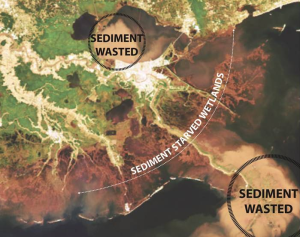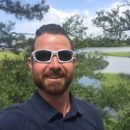We have much more to do and your continued support is needed now more than ever.
5 Steps Toward Restoring the Gulf of Mexico
Nearly five years ago, BP’s Deepwater Horizon oil rig exploded, setting off a catastrophe that killed 11 men and sent more than four million barrels of oil deep into the Gulf. Recently, scientists mapped the location of a portion of the remaining oil—finding it in a sort of blotchy “bathtub ring” roughly the size of Rhode Island.
BP has been found ‘grossly negligent,’ and the company could end up paying as much as $18 billion in civil penalties under the Clean Water Act, much of which will be sent to the states for restoration purposes.

The projects in this report generally follow five principles that could help guide the restoration of the Gulf of Mexico and ensure that these dollars are spent wisely.
1. Restore Sediment Supply

But the Mississippi River is straitjacketed by levees from the Midwest to the bottom of Louisiana’s boot toe. Sediment that once fed Louisiana’s coastal wetlands is now sent into the Gulf of Mexico. Louisiana’s wetlands and marshes are disappearing rapidly, in part because they are starved of the river’s sediment and fresh water. Without sand from the river, many barrier islands are also rapidly eroding—and offering less protection from storms. In total, Louisiana’s coastline loses an average of a football field of land every hour. Projects to strategically reconnect the river’s freshwater and sediment with the eroding wetlands could restore and rebuild as much as 300 square miles of wetlands by 2060 that would otherwise be lost.
2. Restore Wetlands
The Gulf Coast is home to more than half of all saltwater wetlands in the country and the Gulf region contains more than a third of the nation’s freshwater wetlands. Wetlands play a critical role in the Gulf ecosystem—providing habitat, filtering pollutants, stabilizing shorelines, and providing protection from storms. Wetlands also support the seafood and recreational fishing industries. The most recent federal study shows that wetlands losses in in the Gulf region were massive—with 260,000 acres of wetlands having disappeared over a five-year period.
3. Restore the Balance between Fresh and Salt Water
Over the past hundred years, most of the major rivers that flow into the Gulf of Mexico have been substantially altered in one way or another. Many rivers have been dammed; their water diverted for use in cities or for agriculture. But the areas where rivers flow into the Gulf—ecosystems called estuaries—are vital for young fish, crabs, shrimp, oysters, and most of the species of fish we eat. With populations in cities rising, important estuaries such as Galveston Bay in Texas may not have enough fresh water to maintain their function as the nurseries of the Gulf.
4. Restore Oyster Reefs

But oyster reefs have declined dramatically across the Gulf’s estuaries for a multitude of reasons, including overharvesting, dredging, and changes in the quality, quantity and timing of fresh water flowing into the estuary. For example, Mississippi Sound and Pensacola Bay are estimated to have each lost more than 90% of their historical oyster reefs. But despite this decades-long decline, the Gulf coast still produces two-thirds of the nation’s oysters. Restoring oyster reefs will improve water quality and boost the health of the Gulf, while protecting shorelines from storms.
5. Protect Critical Landscapes
The five states bordering the Gulf of Mexico cover a vast amount of territory, 86% of which is in private hands. This adds up to 250 million acres of privately held agricultural and forested lands—a number that is impossible to ignore when attempting to improve the health of the Gulf Coast. Many private landowners are playing an integral role in the long-term recovery of the Gulf of Mexico’s watershed by restoring long-leaf pine habitats or supporting efforts to protect water quality. When and where appropriate, key parcels of coastal lands such as important habitats around Mississippi’s Grand Bay National Wildlife Refuge should to be purchased in order to protect them into perpetuity.
Speak up for Gulf Restoration
![]() Make sure that every penny of the BP’s fines are spent restoring Gulf habitats.
Make sure that every penny of the BP’s fines are spent restoring Gulf habitats.






















